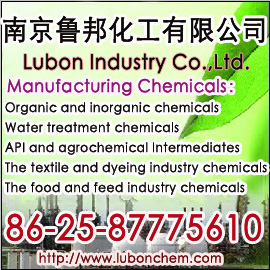Use role
Widely used in the following industries:
1, Food: general cold drinks, beverages, jellies, popsicles, pickles, preserves, pastries, fruits, protein and sugar. Used in the food industry and for sweetening diabetic diet, the widespread use of synthetic sweet ignorant agent. [3]
2, feed additives: pig feed, sweet, etc.
3, daily chemical industry: toothpaste, mouthwash, eye drops, etc.
4, electroplating industry: electroplating grade Sodium Saccharin is mainly used in nickel plating, is used as a brightener. Plus a small amount of sodium saccharin, the nickel plating can improve the brightness and softness. Average usage per liter of syrup with 0.1 – 0.3 g
Electroplating industry where a larger amount, total exports accounted for the majority of Chinese production.
Product hazards
Since 2005, saccharin in food applications significantly beyond the scope, excess phenomenon. Some manufacturers in order to reduce the cost of earning profits, in beverages, jellies and even preserved exclusively for consumption by children and other foods, the widespread use of harmful useless saccharin instead of sugar, but not on food labels to make any express or dubbed “protein sugar “,” sweet treasure “and reputation to cover up the fact that the use of saccharin, damage to the health of consumers, a serious violation of the consumer’s right to know, has attracted the close attention of the community and consumers.
Saccharin chemical name orthobenzoyl imide, market sales of goods of saccharin is actually soluble sodium o-benzoyl imide, referred to sodium saccharin. Sodium Saccharin is about 300 to 550 times the sweetness of sugar, so the solution one hundred thousandth of that sweet sense of bitterness will appear after high concentrations.
The main raw material for the manufacture of saccharin toluene, chlorine acid, o-toluidine, etc., are all petrochemical products. Toluene volatile and burning, and even cause an explosion, a high intake can cause acute poisoning the body, harmful to human health; chlorine acid decomposition of highly absorbent hydrogen chloride gas, harmful and explosive; saccharin production process intermediate substances on human health are also hazards. Saccharin in the production process but also serious environmental pollution. In addition, some small inflow of medium and small privately saccharin factory towns, rural markets saccharin, but also because the process is rough, the process is not complete and other reasons which contain heavy metals, ammonia compounds, arsenic and other debris. Their long-term retention in the body, accumulation, to varying degrees, affect human health.
As the consumption of saccharin detrimental to human health, so some western developed countries have strict controls on the use of saccharin and its control standards is generally not more than 5% of the total consumption of sugar, and is mainly used in toothpaste and other industrial uses. In China, compared with developed countries, the use of saccharin amount exceeds 14 times the normal usage. More experts warned that the second half of 1999, the National Sugar sweetener market share has up to 55% to 60% of the total market share, severe crowding share sucrose.
2 kg saccharine sweetness due to the equivalent of 1000 kg of sugar, according to market
Sodium Saccharin packaging
Sodium Saccharin packaging
Rigby calculated that 60 to 70 per saccharin, can replace sugar 3,000 yuan. As a result, some enterprises in order to chase profits in the production of beverages and processed foods during excessive, beyond the scope of the use of saccharin, but the food and beverage labels do not indicate containing saccharin and its real content, so consumers have the misconception that eating the sugar damages the health of consumers, but also a serious violation of the consumer’s right to know.
Especially in a small number of consumers do not know saccharin hazardous situation, a short time to eat a lot of saccharin, cause, etc., causing acute thrombocytopenia and bleeding, multiple organ damage, triggering a vicious poisoning.
On China’s vast market of small towns and rural areas, the use of saccharin has reached flood stage. According to the China Consumers’ Association survey recently on the domestic beverage nearly 100 different grades, types of shows that the whole country is concerned, there are about 61.2 percent of the drinks contain various types of sweeteners, refined sugary drinks which reached 55.1%; 23.5% of drinks but did not indicate the use of saccharin in the label in production; especially in small towns and rural markets, beverages containing up to 90.9% saccharin, saccharin rampant shocking.
In the primary school snacks, saccharin can not be ignored. In some primary and secondary schools around throughout a variety of small food stalls selling all kinds of snack foods and beverages, such as soft drinks, ice cream, plum and so on. These values are not high, small food and drinks, it is easy to attract schoolchildren to buy. However, neither of these production standards and did not identify and source products, basically contain saccharin, long-term consumption will lead young people to malnutrition, anorexia behavior of individuals, interferes with the normal dietary intake of adolescent nutrition, adolescent body negative impact on growth.
To this end, China Consumers Association issued a solemn warning: draw the relevant departments to formulate more stringent requirements saccharin use and further strengthen the management of food labeling; appeal to the majority of food manufacturers do not blind pursuit of profit because of one-sided use of saccharin, harm consumers health, and clearly indicate the state allows the use of products containing saccharin saccharin so that the consumer’s information; to safeguard the legitimate interests of consumers; remind consumers establish a good concept of consumption, eat more natural sugars in the purchase of food and when you drink, carefully read the product label, try to choose never sugary refined foods, buy reputable commodity; also reminded parents of the students to educate their children, and resolutely resist the campus around the “three noes” small food and beverages to conducive to the healthy growth of young people.

